If you want to know about the introduction of pile foundation or types of concrete and its uses or concrete mix design, please click the link.
Foundations are structures that support the weight of a building or other structures and transfer it to the underlying soil or rock. There are various types of foundations that are used depending on the soil conditions and the load of the structure.
1) Introduction of foundation
- A structure essentially consists of two parts, namely the super structure which is above the plinth level and the substructure which is below the plinth level.
- Substructure is otherwise known as the foundation, and this forms the base for any structure.
- Generally, about 30% of the total construction cost is spent on the foundation.
- The soil on which the foundation rests is called the “foundation soil”.
2) Objectives of a foundation
A foundation is provided for the following purposes.
- To distribute the total load coming on the structure on a larger area.
- To support the structures.
- To give enough stability to the structures against various disturbing forces, such as wind and rain.
- To prepare a level surface for concreting and masonry work.
3) Factors affecting design of foundation
- Soil types and ground water table conditions.
- Structural requirements and foundations.
- Site condition and environmental factor.
- Economy etc.
4) Types of foundation
Foundations can generally be categorized into three types:
- Shallow foundations
- Deep foundations
- Special foundations
Shallow foundation:
These are used when the soil is stable and can support the load of the structure. Examples include spread footing, mat foundation, and slab-on-grade.
- Isolated footing (single footing, Column footing)
- Combined footing
Deep foundation:
These are used when the soil is not stable enough to support the load of the structure, or when the structure needs to be raised above the ground level. Examples include piles, drilled shafts, and caissons.
- Pile foundation
- Well foundation
Special foundations:
These are used when the soil conditions are extreme, or when the structure needs to be built in an unusual location. Examples include floating foundations, underwater foundations, and seismic isolation foundations.
5) Types of Shallow foundation
- Shallow foundation (spread foundation): Depth of foundation is less than or equal to its width.
i) Isolated footing (single footing, column footing)
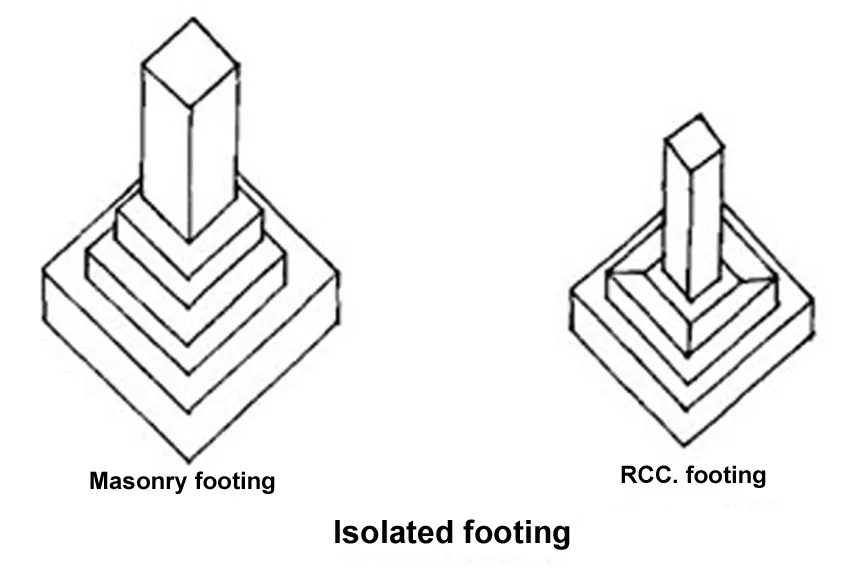
- In framed structures where several columns are to be constructed, isolated footings can be adopted.
- The columns involved can be provided with masonry or concrete footing.
- If masonry footing is provided, steps are given and the foundation area is thus increased so that the stresses developed at the base is within the limit.

ii) Combined footing
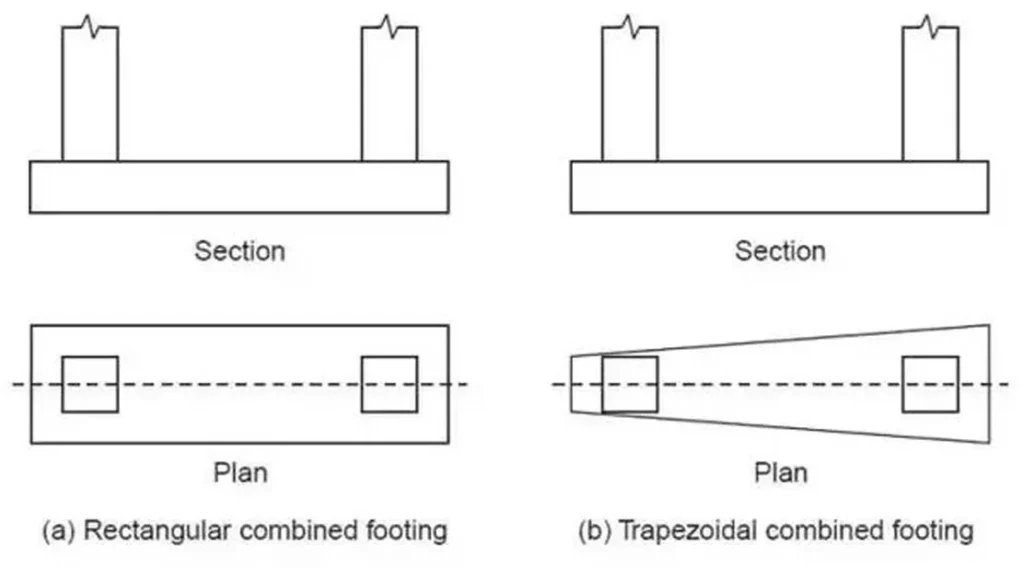
- This type of footing is adopted when the space between two columns is so small that the foundation for individual columns will overlap.
- Combined footings are proportioned in such a way that the center of gravity of the loads coincides with the centre of gravity of the foundation.
a) Strap Combined Footing
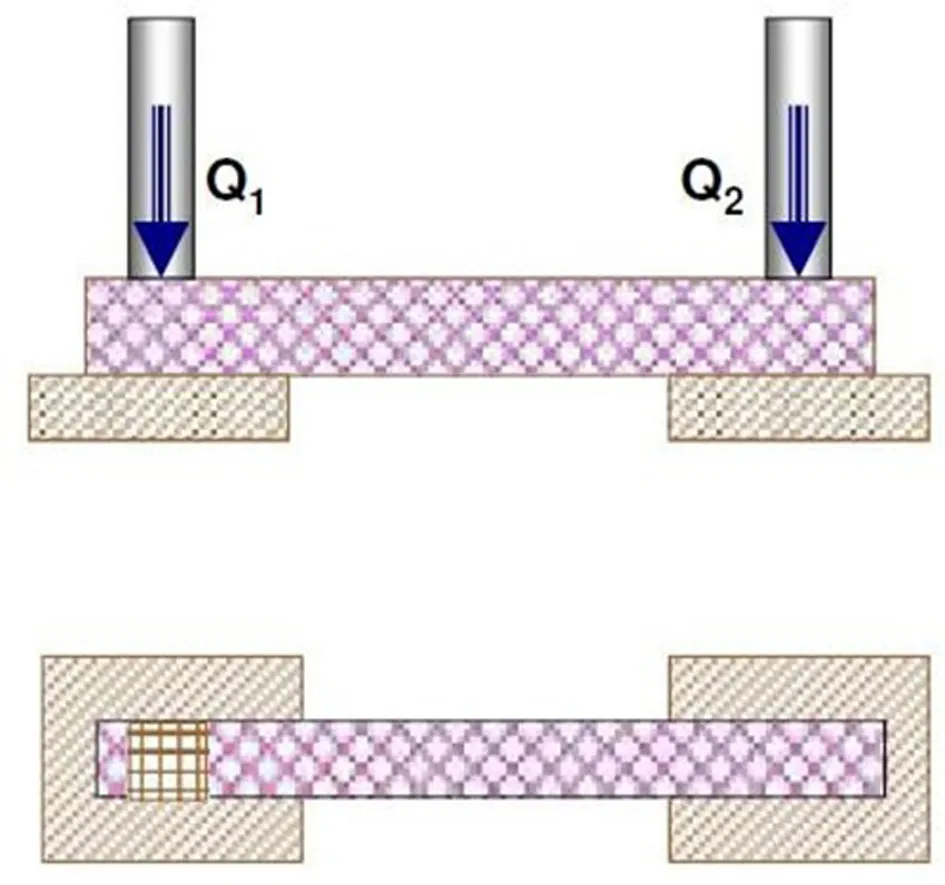
- Strap footing is used to connect an eccentrically loaded column footing to an interior column so that the moment can be transferred through the beam and have uniform stress distribution beneath both the foundations.
- This type of footing is preferred over the rectangular or trapezoidal footing if distance between the columns is relatively large.
- Some design considerations:
- Strap must be rigid: I strap / I footing > 2
- Footings should be proportioned to have approximately equal soil pressure in order to avoid differential settlement.
- Strap beam should not have contact with soil to avoid soil reaction to it.
b) Raft Foundation
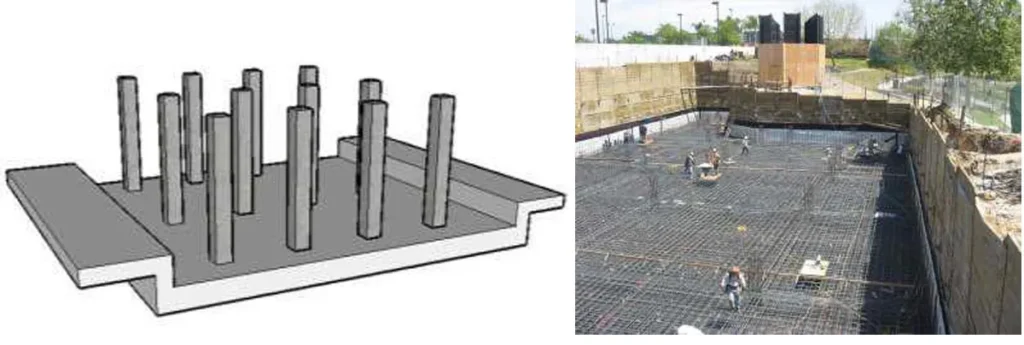
- The raft foundation is a continuous footing that covers the entire area beneath a structure and supports all the walls and columns.
- The principle of any raft foundation is to spread the load of the entire area of the site.
- It may be stiffened by ribs or beams incorporated into the foundation.
- They are made up of concrete and heavily reinforced with steel, so entire foundation will act as a unit.
- The term mat is also used for the foundation.
- A raft is an alternative to piles as it can be less expensive.
Where are raft foundations used?
- The raft foundations are used where the column load are heavy and thus requiring large bases.
- Where the bearing capacity of soil is low, resulting in the need of large base.
- If the subsoil is soft compressible such as soft clay or peat.
- If the bottom of the structure is located below the ground table level.
- It is also used where the area covered by spread footings is more than half the area covered by the structure.
C) Flat plate raft foundation
- These are constructed of uniform thickness over the whole raft area.

- Flat plate thickened under foundation – These are constructed of uniform thickness over the whole raft area.
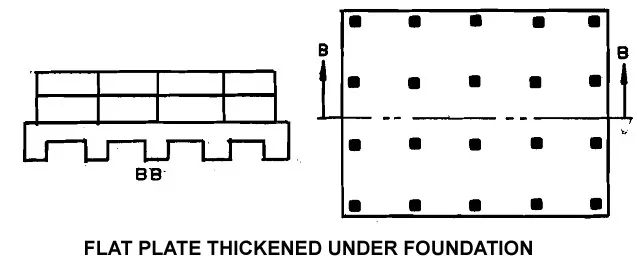
d) Beam and slab Raft foundation

- Beam and slab rafts are alternatives to the solid slab raft and are used where poor soils are encountered.
- The beams are used to distribute the column load over the area of the raft, that results in the reduction of the slab thickness.
- The beams can be up stand or down stand depending upon the bearing capacity of soil near the surface.
6) Some considerations for Shallow Foundation Design
- For economical design, it is preferred to have square footing for vertical loads and rectangular footing for the columns carrying moment.
- Allowable bearing pressure should not be very high in comparison to the net loading intensity leading to an uneconomical design.
- It is preferred to use SPT or Plate load test for cohesionless soils and undrained shear strength test for cohesive soils.
- In case of lateral loads or moments, the foundation should also be checked to be safe against sliding and overturning.
- The FOS shall not be less than 75 against sliding and 2.0 against overturning.
- When wind/seismic loads are considered, the FOS is taken as 1.5 for both the cases.
7) Types of Deep foundation
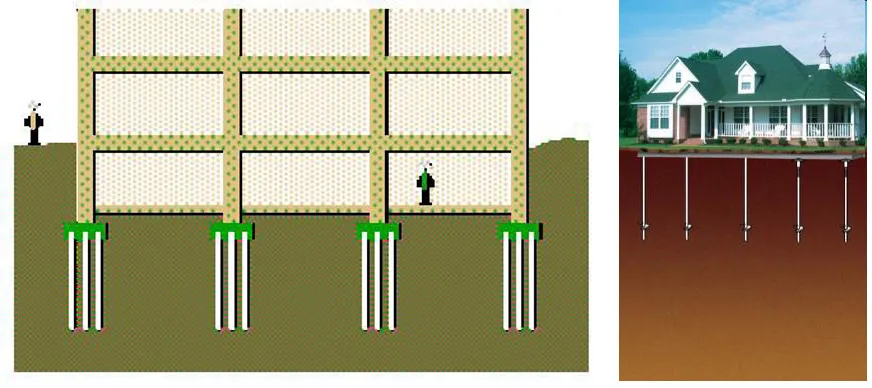
- Deep foundation consists of pile and pier
- This consists in carrying down through the soil a huge masonry cylinder which may be supported by the sides of soil or may be supported on solid rock (hard stratum).
i) Pile foundation

- Pile is an element of construction used as foundation.
- It may be driven in the ground vertically or with some inclination to transfer the load safety.
Pile foundation is used when
- The soil near the surface doesn’t have sufficient bearing capacity (weak) to support the structural loads.
- The estimated settlement of the soil exceeds tolerable limits
- Differential settlement due to soil variability or non-uniform structural loads is excessive.
- Excavations to construct a shallow foundation on a firm soil are difficult or expensive.
ii) Well foundation

- Well foundation is a box of timber, metal, reinforced concrete or masonry which open both at the top and bottom, and is used for building and bridge foundations.
- Types of well shapes:
- Circular
- Rectangular
- Double – D
- Twin circular.
8) Location and depth of Foundation
- IS:1904-1986: Minimum depth of foundation = 50 m.
- Foundation shall be placed below the zone of
- Excessive volume change due to moisture variation (usually exists within 5 to 3.5 m depth)
- Topsoil or organic material
- Unconsolidated material such as waste dump
- Foundations adjacent to flowing water (flood water, rivers, ) shall be protected against scouring.
- A raised water table may cause damage to the foundation by
- Floating the structure
- Reducing the effective stress beneath the foundation
- Water logging around the building: proper drainage system around the foundation may be required so that water does not accumulate.
9) Types of Foundations Based on Soil Investigation
- For most of the fine grained soils (containing silt and clays) it might be sufficient to use simple spread footings, it is largely depending on the magnitude of the load.
- The location of the foundations in relation to the soil (need to be aware of foundation walls and hydrostatic pressure as moisture is present in the soil).
- If the soil is poor and structure loads are relatively heavy, then alternate methods are required.
- Pile foundations might be required in some cases where fine cohesive silt and clay soil is present (CH, OH).
- Sometimes it might be desirable and economically feasible to over excavate remove such soils that are not of bearing capacity; can remove compact and fill back or import other engineered soil.
- The geotechnical engineer based on borings will recommend suitable foundations systems or alternative solutions, also beating capacity, minimum depths, and special design or construction procedures might be established.
- Bedrock has the highest safe bearing capacity.
- Well graded gravel and sand that are confined and drained have a safe bearing capacity of 130 ton/m2 – 500 ton/m2.
- Silts and clays have lower safe bearing capacity of 50 ton/m2
The choice of foundation type depends on factors such as soil type, structure type, load-bearing capacity, and environmental conditions.